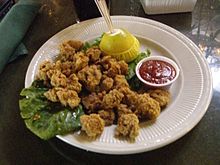- Rocky Mountain oysters
-
Rocky Mountain oysters are bull calf testicles used as food.
They are often deep-fried after being peeled, coated in flour, pepper and salt, and sometimes pounded flat. This delicacy is most often served as an appetizer[1] with a cocktail sauce dip.
North America
It is a well-known novelty dish in parts of the American West and Western Canada where cattle ranching is prevalent and castration of young animals is common ("prairie oysters" is the preferred name in Canada, where they may be served in a demi-glace, not deep-fried).[2] In Oklahoma and North Texas, they are sometimes called calf fries but only if taken from very young animals.[3] In Spain and many parts of Mexico they are referred to as "criadillas," and they are colloquially referred to as huevos de toro (literally, "bull’s eggs"; huevos is a Spanish slang term for testicles) in Central and South America.[4] Rocky Mountain oysters are sometimes confused with lamb fries or animelles (lamb testicles), which are served in a manner similar to Rocky Mountain oysters. A few other descriptive terms, such as "cowboy caviar", "Montana tendergroins", "dusted nuts", "bull fries" or "swinging beef" may be used.[5]
The dish, purportedly cowboy fare,[6] is most commonly found served at festivals, such as the ones in Montana and Phoenix, Arizona, amongst ranching families, or at certain specialty eating establishments and bars.[5] They are, however, also readily available at some well-known public venues (e.g. at Coors Field during Colorado Rockies baseball games). Eagle, Idaho, claims to have the "World's Largest Rocky Mountain Oyster Feed" during its Eagle Fun Days (typically the first weekend in June).[7] Usually this meat product is sold frozen, as it is inconvenient to get testicles fresh anyplace other than on the range.[5]
The primary goal of testicle removal is not necessarily culinary. Castration in veterinary practice and animal husbandry is common and serves a variety of purposes, including the control of breeding, the growth of skeletal muscle suitable for beef, and temperament alteration.[8]
References
- ^ Linda Stradley, http://www.deependdining.com/2004/09/rocky-mountain-oysters-old-mill-cedar.html
- ^ http://www.metacafe.com/watch/1479766/testicle_festival_in_calgary_alberta/
- ^ http://www.westonaprice.org/foodfeatures/rockymtoysters.html
- ^ Pensando En Los Huevos Del Toro - Eltiempo.Com
- ^ a b c Rocky Mountain Oysters, prairie oysters, Montana tendergroins, cowboy caviar, swinging beef, calf fries
- ^ Cowboy Grub, by Richard W. Slatta, proprietor of the Lazy S Ranch: Where cowboys roam the Old West
- ^ City of Eagle, Idaho
- ^ Castration: Not Cutting Will Cut Profits
External links
- Earles, Jim. "Rocky Mountain Oysters: Expanding on the List of Organ Meats," The Weston A. Price Foundation.
- Brown, Patricia Leigh. "Delicacy of the Wild West Lives on for Those So Bold," The New York Times, Wednesday, March 18, 2009.
- Lakey, Dwight, Songwriter. "Rocky Mountain Oysters," Songwriter Dwight Lakey's (ASCAP) song about rocky mountain oysters, © 2007 Brown Barn Publishing & Dwight Lakey, Danville, VT & Julesburg CO; All Rights Reserved.
American cuisine Historical Regional Allentown, Pennsylvania · California · Cincinnati · Kentucky · Hawaii · Midwestern · Chicago · New England · New Mexico · New York City · Omaha · Pacific Northwest · Philadelphia · Puerto Rico · Southern · Cajun · Creole · Lowcountry · Barbecue in Texas · Tex-Mex · Floribbean · Southwest · Western
Ethnic American Chinese · Soul food · Native American · Pennsylvania Dutch · Italian American · Tlingit
Miscellanea Categories:- Offal
- North American cuisine
- Appetizers
- Cowboy culture
Wikimedia Foundation. 2010.


